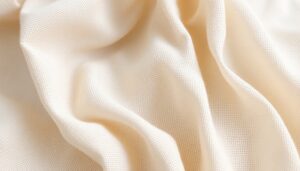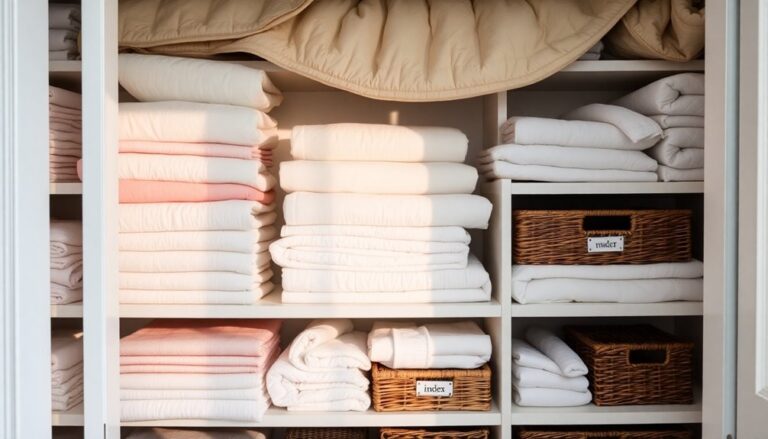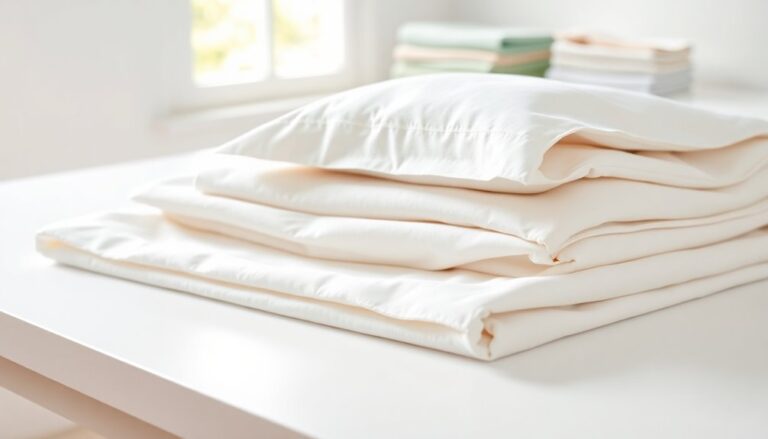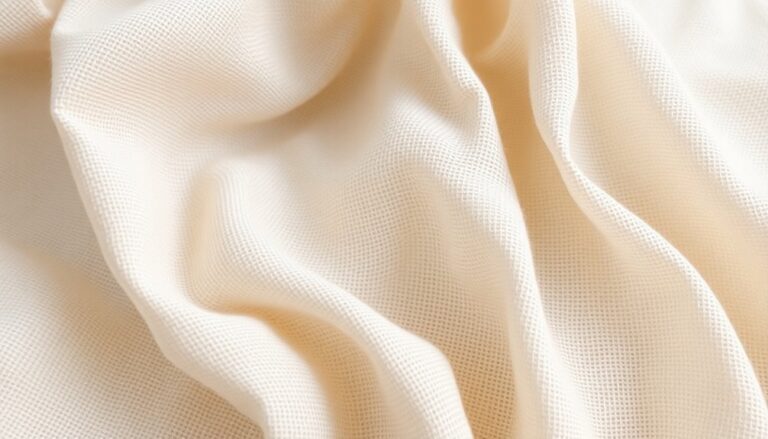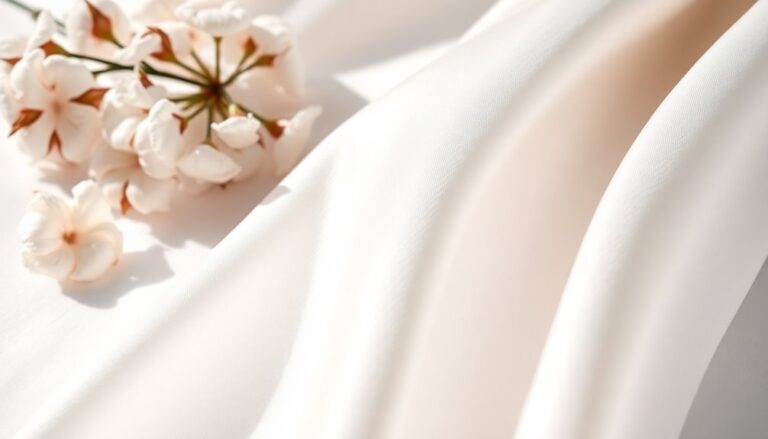To make linens last longer, one should invest in quality materials like Egyptian or Pima cotton. Washing with gentle detergents and at lower temperatures helps preserve fabric integrity. It's likewise important to avoid overdrying by removing linens slightly damp and choosing breathable storage options. Treating stains quickly can prevent permanent damage. With a few simple practices, anyone can maintain their linens effectively. There are even more tips to keep your linens in pristine condition.
Article Highlights
- Choose high-quality materials like Egyptian or Pima cotton for durability and comfort in your linens.
- Wash linens with gentle, eco-friendly detergents in lower temperatures to protect fibers and prolong their lifespan.
- Avoid overdrying by removing linens from the dryer while slightly damp and consider line drying to maintain softness.
- Store linens in breathable bags, avoiding high-humidity areas to prevent damage and odors.
- Treat stains immediately by blotting, rinsing with cold water, and applying gentle detergent directly to the affected area.
Choose Quality Materials

In regards to linens, quality matters. Selecting the right materials can greatly affect the lifespan and comfort of bedding. Cotton types, such as Egyptian and Pima, are renowned for their durability and softness, making them excellent choices for sheets and pillowcases. These high-quality options often outperform standard cotton, providing a luxurious feel that lasts. Furthermore, fabric blends can improve durability; for instance, cotton-polyester blends combine the softness of cotton with the resilience of polyester, reducing wrinkling and fading. By investing in quality materials, one can guarantee that linens not only look great but also withstand the test of time. It's a simple step that can lead to a more comfortable and long-lasting bedding experience.
Wash With Care
In terms of caring for linens, washing with attention can greatly extend their life. Using gentle detergents helps prevent fabric damage, whereas avoiding high heat during washing and drying keeps fibers intact. Following these simple practices can make a noticeable difference in how long linens remain fresh and durable.
Use Gentle Detergents
Using gentle detergents is crucial for prolonging the life of linens, as harsh chemicals can break down fibers over time. Many people overlook the importance of choosing the right detergent, but it can make a significant difference. Eco-friendly options are often formulated without aggressive ingredients, making them kinder to fabrics. These detergents not only protect the material but likewise reduce environmental impact. Furthermore, fragrance-free formulas are an excellent choice for those sensitive to scents or who want to avoid chemical residues. By opting for gentle detergents, individuals can guarantee their linens maintain their softness and durability, ultimately leading to a longer lifespan. Caring for linens with the right products reflects a commitment to quality and sustainability.
Avoid High Heat
Avoiding high heat is essential for maintaining the integrity of linens. In terms of linen care, washing and drying at lower temperatures can greatly extend the lifespan of sheets, towels, and tablecloths. High heat can cause heat damage, leading to fraying, fading, and weakening of fibers. Instead of using hot water and high dryer settings, individuals should opt for cooler washes and air drying when possible. This not only protects the fabric but additionally helps preserve the lively colors and textures that make linens appealing. By being mindful of temperature settings, one can guarantee their linens remain fresh and durable, making them a long-lasting investment in home comfort.
Avoid Overdrying

Overdrying linens can greatly shorten their lifespan, so it is essential to pay attention to drying times. When linens are left in the dryer too long, the heat can weaken the fibers, leading to premature wear and tear. To maintain fabric care, it's best to remove linens from the dryer as they're still slightly damp and allow them to finish drying naturally. Line drying is an excellent alternative, as it not only prevents overdrying but additionally reduces energy consumption. By taking these steps, individuals can guarantee their linens remain soft and durable for years to come. Paying attention to drying times is a simple yet effective way to extend the life of beloved bed sheets, towels, and tablecloths.
Store Properly
To guarantee linens remain in top condition, proper storage is crucial. Using breathable storage bags can help maintain their quality, as keeping them away from moisture prevents damage. This simple approach can greatly extend the life of valuable textiles.
Use Breathable Storage Bags
Regarding storing linens, utilizing breathable storage bags can significantly improve their longevity. These bags are constructed from breathable materials that permit air circulation, preventing musty odors and mildew from forming. Unlike plastic bags, which trap moisture, breathable storage bags assist in maintaining a balanced environment for linens.
When contemplating storage tips, it is crucial to select bags that accommodate your linens without cramming them in, as this can lead to creasing and damage. Furthermore, labeling each bag guarantees easy access and organization. By choosing breathable storage solutions, individuals can safeguard their linens effectively, allowing them to remain fresh and in excellent condition for years. Properly storing linens not only prolongs their lifespan but also keeps them ready for use whenever needed.
Keep Away From Moisture
Even though linens are often stored away for extended periods, it is essential to keep them away from moisture to prevent damage. Humidity control is important for maintaining the integrity of these fabrics. Here are some effective moisture proofing techniques: One effective method is to store linens in a cool, dry place with proper ventilation to reduce humidity buildup. Additionally, using silica gel packets or moisture-absorbing materials can help protect fabrics from damp conditions. When considering how to prevent linen from fading, it is advisable to keep them away from direct sunlight and use breathable storage bags to maintain their color and quality over time.
- Use silica gel packets: These absorb excess moisture and can be placed in storage containers.
- Store in a climate-controlled environment: Keeping linens in a cool, dry room helps prevent dampness.
- Seal tightly: Use airtight containers to minimize exposure to humidity.
- Avoid basements and attics: These areas often have higher moisture levels, making them unsuitable for linen storage.
Rotate Your Linens

Regularly rotating linens is key to extending their lifespan. By implementing linen rotation benefits, individuals can guarantee that their linens experience even wear and tear, preventing specific pieces from becoming worn out too quickly. This strategy allows for a more balanced use of available linens, helping to maintain their quality over time. Seasonal linen swapping is another effective practice; it encourages people to switch out heavier linens for lighter ones according to the changing weather. Not only does this keep the home feeling fresh, but it likewise protects linens from prolonged exposure to unfavorable conditions. By adopting these simple habits, anyone can maximize the durability of their linens, guaranteeing they remain in excellent condition for years to come.
Treat Stains Promptly
When a stain occurs, acting quickly can make all the difference in preserving the integrity of linens. Delaying could lead to permanent damage, so it's important to know effective stain removal techniques. Here are some emergency stain solutions to evaluate:
- Blot, don't rub: Immediately blot the stain with a clean cloth to absorb excess liquid.
- Cold water rinse: Rinse the stained area with cold water to help lift the stain.
- Use gentle detergent: Apply a small amount of mild detergent directly to the stain.
- Test before applying: Always test any stain removal solution on a hidden area first to prevent discoloration.
Frequently Asked Questions
How Often Should I Replace My Linens?
They say, "A stitch in time saves nine," and this rings true for linens. Typically, one's linen lifespan is about two to three years, depending on usage and care. Signs for replacement include fraying edges, fading colors, or persistent stains that won't wash out. Regular inspections can help catch these issues early, ensuring comfort and hygiene in the home. By staying vigilant, one can enjoy fresh linens for longer.
Can I Mix Different Fabric Types When Washing Linens?
Regarding mixing different fabric types during the washing of linens, it's important to take into account fabric care. Different fabrics have unique washing needs, and mixing them can lead to damage or uneven cleaning. It's best to follow washing tips that suggest separating linens by fabric type. This way, each type gets the appropriate care it requires, ensuring they last longer and maintain their quality, regardless of the blend in your laundry basket.
What Is the Best Way to Remove Linen Wrinkles?
In terms of wrinkle removal for linens, steam ironing's often the most effective method. It helps relax the fibers, making it easier to achieve a smooth finish. The key's to use the right temperature settings based on the fabric type; linen requires a higher heat. On the other hand, hanging linens in a steamy bathroom can likewise reduce wrinkles. By following these methods, one can keep their linens looking fresh and crisp.
Are Fabric Softeners Safe for All Linens?
In the dance between softness and strength, the question arises: are fabric softeners safe for all linens? Although they can improve comfort, some linens may suffer. They could lose breathability or absorbency, much like a flower wilting in the shade. Instead, considering fabric softener alternatives, like vinegar or baking soda, can provide linen care tips that preserve their integrity. It's a gentle choice, nurturing both the linens and the love they bring to home.
How Do I Know if My Linens Are High-Quality?
To determine if linens are high-quality, one should consider fabric construction and thread count. High-quality linens often feature a tighter weave and higher thread count, typically above 300, which results in a softer, more durable fabric. Furthermore, natural fibers like cotton or linen are preferable, as they tend to be more breathable and long-lasting. By examining these factors, one can make an informed decision about the quality of their linens.

